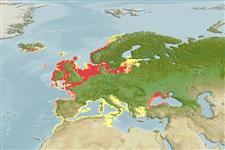| Native range |

|
| Scophthalmus maximus AquaMaps Data sources: GBIF OBIS |
Length at first maturity
Lm 34.7, range 41 - 54 cm
Human uses
Fisheries: commercial; aquaculture: commercial; gamefish: yes; aquarium: public aquariums
Phylogenetic diversity index
(Ref. 82805)
PD50 = 0.5645 many relatives (e.g. carps) 0.5 - 2.0 few relatives (e.g. lungfishes)
Trophic Level
(Ref. 69278)
4.4 ±0.0 se; Based on diet studies.
Resilience
(Ref. 69278)
Medium, minimum population doubling time 1.4 - 4.4 years (K=0.15-0.28; tm=3-5; tmax=26; Fec=5 million)